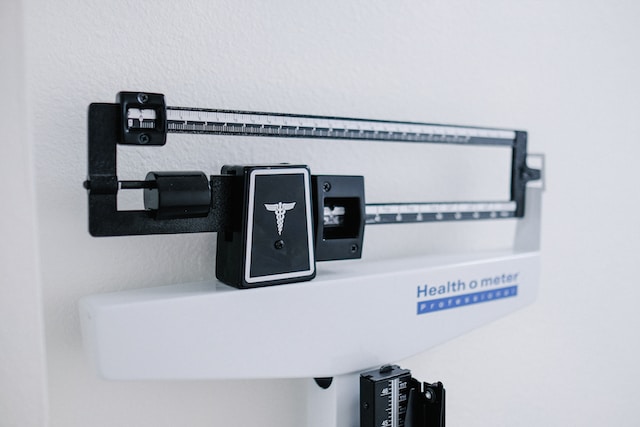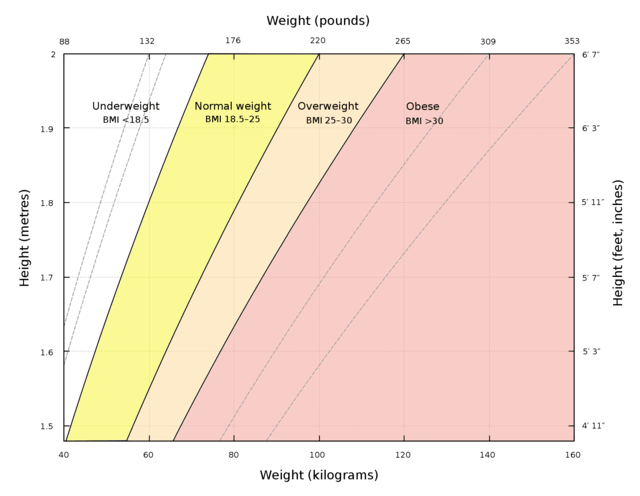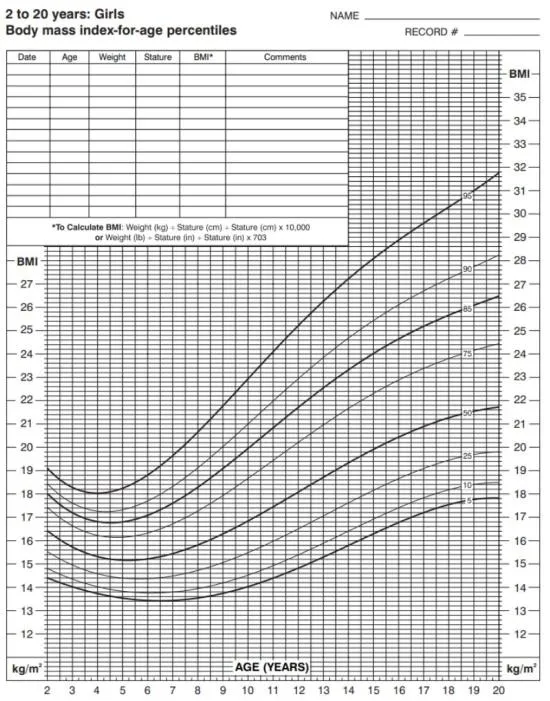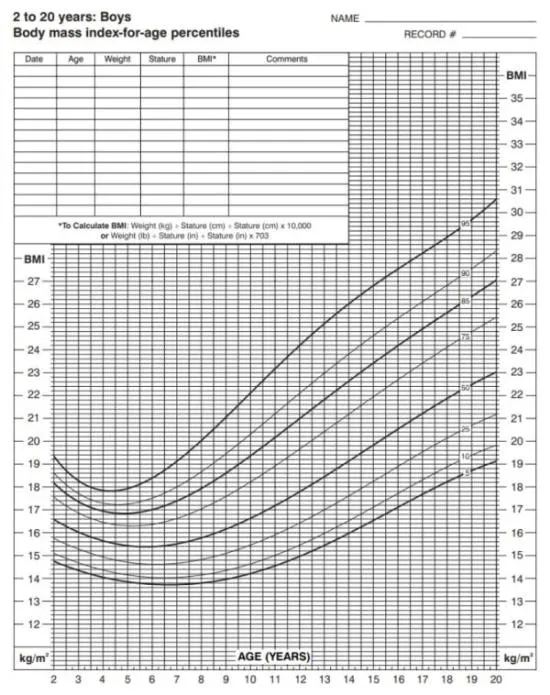How to Use
- Input Your Weight.
- Input Your Height. If "Kids/Teens" is selected, it will also ask your age and gender.
- Click on the "Calculate" button.
- View your Results.
What is BMI?
BMI (Body Mass Index) is a measurment based on a person's weight and height. It is a simple and cost-effective way to determine whether someone falls into the underweight, healthy weight, overweight, or obese category. While BMI does not directly measure body fat, it is moderately linked to more direct measures of body fat. Additionally, research suggests that BMI is similarly associated with metabolic and disease outcomes as these more direct measures of body fatness.

What is a BMI Calculator?
A BMI (Body Mass Index) calculator is a tool used to estimate an individual's body fat based on their weight and height. It is a numerical value derived from a mathematical formula that helps categorize individuals into different weight status categories. The BMI is often used as a simple and quick screening tool to assess whether a person has a healthy body weight in relation to their height.
The BMI is calculated using the following formula:
BMI = Weight (kg) / Height (m)^2
For measurements in pounds and inches, the formula is slightly different:
BMI = Weight (lbs) \ Height (in)^2 * 703
BMI Calculator for Women and Men
The basic BMI formula is the same for men and women, but the interpretation of BMI categories may vary slightly.
The BMI categories are generally as follows:
- Underweight: BMI less than 18.5
- Normal weight: BMI between 18.5 and 24.9
- Overweight: BMI between 25 and 29.9
- Obese: BMI of 30 or greater
| Classification | BMI range |
|---|---|
| Underweight | < 18.5 |
| Normal weight | 18.5 - 25 |
| Overweight | 25-30 |
| Obese | > 30 |

It's important to note that while BMI is a useful screening tool, it does not directly measure body fat and may not be accurate for everyone. Factors such as muscle mass, distribution of fat, and variations between individuals of different ethnicities can influence BMI results. As such, BMI should be considered alongside other health assessments for a more comprehensive evaluation of an individual's health.
BMI Calculator for Children and Adolescents (ages 2-20)
For children and adolescents, BMI is interpreted differently because their bodies undergo different growth patterns. Age and sex-specific BMI percentiles are used to categorize children and adolescents into weight status groups.
The BMI formula for children is the same as for adults, but the interpretation involves comparing the child's BMI to the BMI-for-age percentiles on growth charts provided by health organizations.
Measuring Height and Weight for Children At Home.
The BMI for children and adolescents are generally as follows:
- Underweight: BMI below the 5th percentile
- Normal weight: BMI between the 5th and 84th percentiles
- Overweight: BMI between the 85th and 94th percentiles
- Obesity: BMI at or above the 95th percentile
| Classification | Percent range |
|---|---|
| Underweight | < 5% |
| Normal weight | 5% - 84% |
| Overweight | 85% - 95% |
| Obese | > 95% |
BMI Chart for Girls

BMI Chart for Boys

What are the Limitations of BMI?
BMI (Body Mass Index) has several limitations that should be considered when assessing an individual's weight and health. One of the primary drawbacks is that BMI does not differentiate between muscle and fat, leading to potential misclassifications, especially for individuals with high muscle mass.
Additionally, BMI lacks consideration for body composition and fat distribution, meaning two people with the same BMI may have different health profiles. It provides no information about overall health or specific health risks, and its applicability varies across populations, including athletes and older adults. BMI may not accurately capture growth patterns during puberty, and its categories for children and adolescents are age- and gender-specific. Importantly, BMI does not account for waist circumference, a crucial factor in assessing health risks associated with abdominal obesity. Ethnic and racial differences, as well as variations in health risk based on genetics and fitness levels, are not adequately addressed by BMI.
Overreliance on BMI alone may lead to overdiagnosis or underdiagnosis of weight-related health conditions. Therefore, while BMI is a convenient screening tool, it should be used alongside other health assessments, with healthcare professionals considering a broader range of factors for a comprehensive evaluation of an individual's health and risks.
BMI Alternatives
While BMI is a widely used tool, several alternatives to BMI are used to provide a more nuanced assessment of body weight and health.
-
Body Composition Analysis
- This method assesses the proportion of muscle, fat, water, and other tissues in the body. Techniques like Dual-Energy X-ray Absorptiometry (DEXA), bioelectrical impedance analysis (BIA), and underwater weighing are used to measure body composition accurately.
-
Waist-to-Hip Ratio (WHR)
- WHR compares the circumference of the waist to that of the hips. A higher ratio indicates a greater amount of abdominal fat and may be associated with an increased risk of certain health conditions.
-
Waist-to-Height Ratio (WHtR)
- WHtR assesses the distribution of body fat by comparing waist circumference to height. It may be a more reliable indicator of health risks associated with abdominal obesity, as it accounts for variations in height.
-
Skinfold Thickness Measurements
- Skinfold calipers are used to measure the thickness of subcutaneous fat at various body sites. The sum of these measurements can provide an estimate of body fat percentage.
-
Body Mass Index for Specific Populations
- BMI categories can be adjusted for specific populations, such as Asians, who may have different health risks associated with BMI levels. Population-specific BMI classifications consider variations in body composition.
-
Visceral Fat Measurement:
- Imaging techniques like Magnetic Resonance Imaging (MRI) and Computed Tomography (CT) scans can directly measure visceral fat, which is fat stored around internal organs and is linked to health risks.
-
Dual-Energy X-ray Absorptiometry (DEXA)
- DEXA scans provide a detailed analysis of body composition, including bone density, lean mass, and fat mass. It is often used in clinical settings for a comprehensive assessment.
-
Bioelectrical Impedance Analysis (BIA)
- BIA measures the resistance of electrical flow through the body, estimating body composition based on the principle that fat and lean tissues conduct electricity differently.
When discussing alternatives to BMI, it's crucial to consider the strengths and limitations of each method and recognize that no single measurement is perfect. Healthcare professionals often use a combination of these tools and consider other factors like lifestyle, genetics, and overall health for a comprehensive assessment. These alternatives allows for a more personalized and accurate evaluation, considering factors like muscle mass and fat distribution that BMI may overlook.
What are some of the Risks Associated with being Overweight?
Being overweight or obese is associated with various health risks that can impact both physical and mental well-being. Here are some of the key health risks associated with being overweight:
- Cardiovascular Diseases
- Type 2 Diabetes
- Metabolic Syndrome
- Joint Problems
- Sleep Apnea
- Respiratory Issues
- Liver Diseases
- Cancer
- Mental Health Issues
- Reduced Quality of Life
It's important to note that the severity of these risks can vary among individuals, and factors such as genetics, overall health, and lifestyle choices also play a role. Maintaining a healthy weight through balanced nutrition, regular physical activity, and overall wellness practices is crucial for reducing the risks associated with being overweight. Individuals concerned about their weight and health should seek guidance from healthcare professionals for personalized advice and support.
What are some of the Risks Associated with being Underweight?
Being underweight is associated with its own set of health risks, and individuals with insufficient body weight may face various challenges. Here are some of the risks associated with being underweight:
- Nutritional Deficiencies
- Weakened Immune System
- Osteoporosis
- Menstrual Irregularities
- Fertility Issues
- Muscle Loss
- Impaired Growth and Development
- Anemia
- Increased Risk of Infections
- Mental Health Issues
- Reduced Fertility in Men
- Electrolyte Imbalances
It is crucial to recognize that the health dangers linked to being underweight can differ depending on the root causes and personal situations. Dealing with concerns of being underweight typically requires a holistic strategy encompassing nutritional advice, medical assessment, and, in certain instances, psychological assistance. People who are underweight and worried about their health should consult healthcare experts for a thorough evaluation and suitable measures.
Maintaining a healthy lifestyle

Maintaining a healthy lifestyle involves adopting habits that promote overall well-being, including achieving and maintaining a normal BMI (Body Mass Index). Here are some key strategies to help you maintain a healthy lifestyle and achieve a normal BMI:
-
Balanced Nutrition
- Eat a well-balanced diet that includes a variety of fruits, vegetables, whole grains, lean proteins, and healthy fats. Pay attention to portion sizes and avoid excessive consumption of processed foods, sugary snacks, and high-calorie beverages.
-
Regular Physical Activity
- Engage in regular physical activity to support weight management and overall health. Aim for at least 150 minutes of moderate-intensity aerobic exercise or 75 minutes of vigorous-intensity exercise per week or 30 minutes of moderate-intensity exercise per day, along with muscle-strengthening activities on two or more days.
-
Hydration
- Stay adequately hydrated by drinking plenty of water throughout the day. Limit the intake of sugary drinks and excessive caffeine. Proper hydration supports overall health and can contribute to weight management.
-
Adequate Sleep
- Prioritize good sleep hygiene by getting 7-9 hours of quality sleep each night. Lack of sleep can affect metabolism, appetite regulation, and energy levels, potentially impacting weight management.
-
Stress Management
- Practice stress-reducing techniques such as mindfulness, meditation, deep breathing, or yoga. Chronic stress can contribute to unhealthy eating habits and weight gain.
-
Regular Health Check-ups
- Schedule regular check-ups with healthcare professionals to monitor your overall health, including weight, blood pressure, cholesterol levels, and blood sugar. Early detection of potential health issues allows for timely intervention.
-
Limit Alcohol Intake
- If you consume alcohol, do so in moderation. Excessive alcohol intake can contribute to weight gain and negatively impact overall health.
-
Social Support
- Surround yourself with a supportive social network. Friends and family can provide encouragement, share healthy habits, and contribute to your overall well-being.
-
Mindful Eating
- Practice mindful eating by paying attention to your hunger and fullness cues. Avoid distractions, such as watching TV or using electronic devices, while eating. This can help prevent overeating.
-
Consistency and Moderation
- Focus on making sustainable lifestyle changes rather than resorting to fad diets or extreme measures. Consistency and moderation in your approach to nutrition and physical activity contribute to long-term success.
-
Set Realistic Goals
- Set achievable and realistic goals for your health and well-being. Celebrate small successes, and be patient with yourself as you work toward your objectives.
-
Educate Yourself
- Stay informed about nutrition, physical activity, and overall health. Understanding the principles of a healthy lifestyle empowers you to make informed choices.
Remember that individual needs and preferences vary, so it's essential to tailor these recommendations to your specific circumstances. Consult with healthcare professionals or registered dietitians for personalized advice and guidance on maintaining a healthy lifestyle and achieving a normal BMI.
Questions to ask your Doctor

- What is my current BMI, and how does it categorize my weight status?
- What BMI range is considered normal for someone of my age and gender?
- How does BMI factor into my overall health assessment?
- Are there any limitations or drawbacks to using BMI as an assessment tool?
- What are the potential health risks associated with my current BMI?
- How does my BMI relate to other health markers, such as blood pressure, cholesterol levels, or blood sugar?
- What is a healthy weight range for me, considering my individual health profile?
- What lifestyle changes can I make to achieve and maintain a healthy BMI?
- Are there underlying health conditions that may be influencing my BMI?
- Can you recommend a registered dietitian or nutritionist to help me with healthy eating habits?
- What role does physical activity play in maintaining a healthy BMI?
- How often should I monitor my BMI, and what other health assessments should I consider regularly?